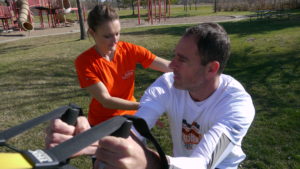By Aaron Boike, B.S. Kinesiology, ACE Certified Personal Trainer
In the past decade, the fitness world has taken a pretty big turn away from vanity and looks focused programs to functional and athletic based regimes. The reality is, most people don’t want to look like Arnold, they want to move better, be healthy, and have that toned athletic look. What does “move better” mean? It means having the strength, mobility, and flexibility to perform all of your activities of daily living, recreational athletics, and whatever other physical challenges life throws at you with little risk of injury or pain.
While there is a myriad of protocols out there used by fitness professionals to test mobility, the most common and well respected is the Overhead Squat Assessment. Originally popularized by Gray Cook’s Functional Movement Screen (FMS) protocol and NASM’s Corrective Exercise protocol, it has stood out as one of the simplest and most effective way to test mobility and muscular balance. In doing this test, you are able to easily identify the areas in need of improvement to move better and with less risk of pain and injury. The protocol explained below is a quick and dirty version of the assessment, and you can find a more detailed solutions table on the National Academy of Sports Medicine Webpage here: http://www.nasm.org/docs/pdf/overhead_squat_solutions_table-(ces-version)-(pdf-40k).pdf?sfvrsn=2
Here’s how you do it:
- Stand barefoot with feet shoulder width apart and hands overhead holding a dowel rod, bodybar or even a broomstick.
- Lower yourself slowly into a squat position – going as low as you can. Think about sitting your hips back as if sitting into a chair.
- Perform several repetitions and take a video or have a friend watch for the following:
- Feet: If your feet turn outward you likely have excessive tension through the calves and/or poor ankle mobility.
- Knee: If your knees want to turn inward, you likely have weak glutes and/or over tight hip flexors.
- Shifting: If you shift to the right or left, there is likely a muscular balance and stability problem – this can often be corrected with consistent lower body exercise with proper form.
- Low Back Arching (Hyperextending): This often indicates tension through the hip flexors and weakness through the core.
- Low Back Rounds: Often indicates a weak core and/or over tight hamstrings.
- Arms Fall: Overtimes indicates weakness through the postural muscles of the upper back (trapezius, rhomboids, teres minor, rotator cuff) and/or tension through the pectorals, lats and anterior shoulders.
While this is a quick version of what can be a very detailed assessment, it allows you to gain some insight into the mobility and muscular balance issues with your body. To get a detailed overhead squat assessment, get set-up with a complimentary Fitness Assessment with a member of our Nationally Certified Personal Training team and specifically request to have an Overhead Squat Assessment done.
References:
- Cook G, Burton L, Kiesel K, Rose G, Bryant M. Movement: Functional Movement Systems. Screening Assessment Corrective Strategies. On Target Publications, 2010.
2. Nickelston, P. DC, The Overhead Squat Assessment, http://www.dynamicchiropractic.com/mpacms/dc/article.php?id=55111, Accessed on 4/19/16
